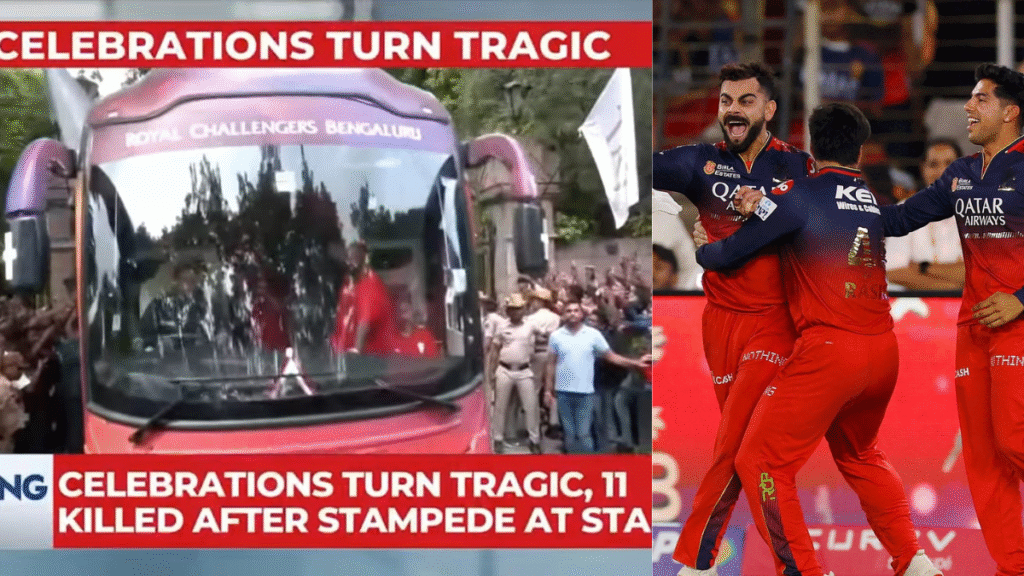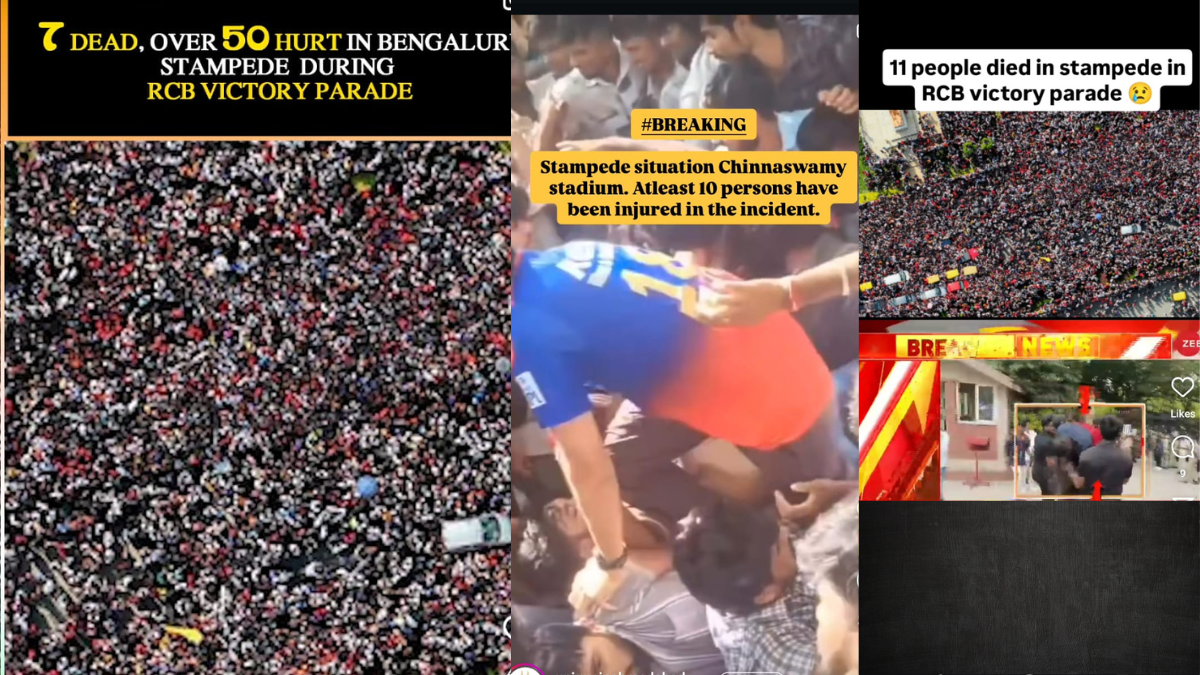In what was meant to be a night of electrifying jubilation for Royal Challengers Bengaluru (RCB) fans euphoria swiftly spiraled into horror. A deadly stampede erupted during the team’s victory celebration in Bengaluru, leaving 10 people dead and dozens injured shattering the festive atmosphere and raising critical questions about crowd management and public safety in the heart of Karnataka’s capital.At least seven people are feared dead and more than 40 others injured following a stampede at Chinnaswamy Stadium in Bengaluru, where massive crowds had gathered to celebrate RCB’s recent victory.Amid growing panic and speculation, Karnataka Deputy Chief Minister D.K. Shivakumar addressed the media, stating: “We have no official confirmation of any deaths linked to the RCB celebrations yet. We will share verified information as soon as details emerge.”
He further emphasized the sensitive nature of the crowd, saying, “It was a young and energetic gathering—we couldn’t resort to lathi-charge to control them.”
From Roars of Joy to Screams of Chaos
It all began with joy. The streets of Bengaluru were painted red and gold after RCB clinched a long-awaited win, marking a significant turnaround in their IPL 2025 campaign. Thousands of passionate supporters flooded MG Road, Brigade Road and surrounding areas, chanting slogans, waving flags and lighting fireworks. What started as uncontained celebration soon mutated into pandemonium when crowds surged uncontrollably toward a live screening stage set up by local organizers.
Within minutes, the situation became unmanageable. Barricades collapsed. People fell. Panic set in. Eyewitnesses described the moment as “pure chaos”—a human tide crushing everything in its path.
Stampede Triggered by Firecracker Misfire?

Initial reports suggest the tragic stampede was likely triggered by a firecracker misfire that caused sudden fear in the densely packed crowd. Some witnesses claim a loud blast, mistaken for an explosion, incited panic among attendees who were already packed shoulder-to-shoulder.
“I saw people running in all directions. There was no way out. I fell, and bodies piled over me. It felt like I couldn’t breathe,” said 19-year-old Ankit Rao, who was later treated for fractured ribs and dehydration.
Families were torn apart in moments. One mother searched for her 9-year-old son in the aftermath, only to find him unconscious and severely injured near the footpath. Medical responders say many of the victims died from asphyxiation, head injuries and blunt trauma caused by trampling.
Emergency Services Overwhelmed
Emergency responders struggled to make their way through the congested roads. Bengaluru’s traffic, already infamous, became a tragic bottleneck. Ambulances were delayed. Hospitals like Bowring, Victoria, and St. Martha’s were soon overwhelmed with victims, many arriving without any vital signs.
As a result of the chaos, more than 45 people sustained injuries, including critical fractures, contusions and internal bleeding. Among them were children, elderly fans and even local security personnel caught in the melee.
Who Is to Blame?
With fingers being pointed in multiple directions, accountability is the burning question. Critics argue that local authorities and event organizers failed to implement basic crowd control protocols, despite expecting a massive turnout following RCB’s semi-final qualification.
“There was no proper exit strategy. The crowd kept swelling, but there were no dispersal mechanisms, no PA announcements, no police cordon. It was a disaster waiting to happen,” said civic activist Meera Iyer.
The BBMP (Bruhat Bengaluru Mahanagara Palike) and Bengaluru Police, meanwhile have launched parallel inquiries. A high-level investigation committee is expected to be set up by the state government within 24 hours.
Political Fallout and Public Anger
Politicians across the spectrum have jumped into the debate. Karnataka Chief Minister Siddaramaiah expressed “deep sorrow” and announced an ex-gratia of ₹5 lakh to each victim’s family. He has called for an urgent review of public event safety protocols, even suggesting a temporary halt on mass celebrations until proper regulations are enforced.
However, public outrage is building, especially on social media. Hashtags like #RCBStampede, #JusticeForVictims and #BengaluruBleeds are trending on X (formerly Twitter), with citizens demanding resignations and stricter policies.
IPL Celebrations – A Double-Edged Sword?
This is not the first time IPL celebrations have spiraled out of control. While the league has delivered unmatched cricketing entertainment, it has also evolved into a high-octane public spectacle often flirting with safety thresholds.
Security experts now warn that unless crowd control protocols evolve alongside the scale of such events, tragedies like this will repeat.
“Cricket is our heartbeat, but our cities aren’t prepared to host these spontaneous outbursts of fandom. Infrastructure planning has to catch up,” noted urban planner Ramesh Naidu.
Heartbroken RCB Team Responds
The RCB franchise, shocked and dismayed by the incident, released a heartfelt statement:
“We are devastated to learn about the loss of lives during the celebration. Cricket is meant to unite and uplift, not cause suffering. We urge everyone to stay safe and support the grieving families.”
RCB captain Faf du Plessis and star batter Virat Kohli both expressed their condolences, urging fans to honor the victims with silence and compassion instead of celebratory noise.
Where Do We Go From Here?
The tragedy has sparked urgent calls for reform. Experts are calling for:
Pre-approved crowd capacity limits
Dedicated exit zones and crowd dispersal systems
Real-time surveillance with drones
Ban on unsanctioned fireworks during public gatherings
Mandatory emergency medical tents at celebration hotspots
But more than rules, what’s needed is responsibility from fans, organizers, and authorities alike. A moment of joy turned into a mass funeral, all because the system failed to anticipate what passion can look like when left unchecked.
Final Word
What should have been a glorious night etched in cricketing folklore is now a black chapter in Bengaluru’s modern history. The red and gold of RCB now drips with sorrow. As families mourn their loved ones, the city is left with a chilling reminder no celebration is worth a single human life.
Let this tragedy serve as a turning point, not just for Bengaluru, but for every Indian city where joy can if not carefully managed, turn fatally chaotic.
